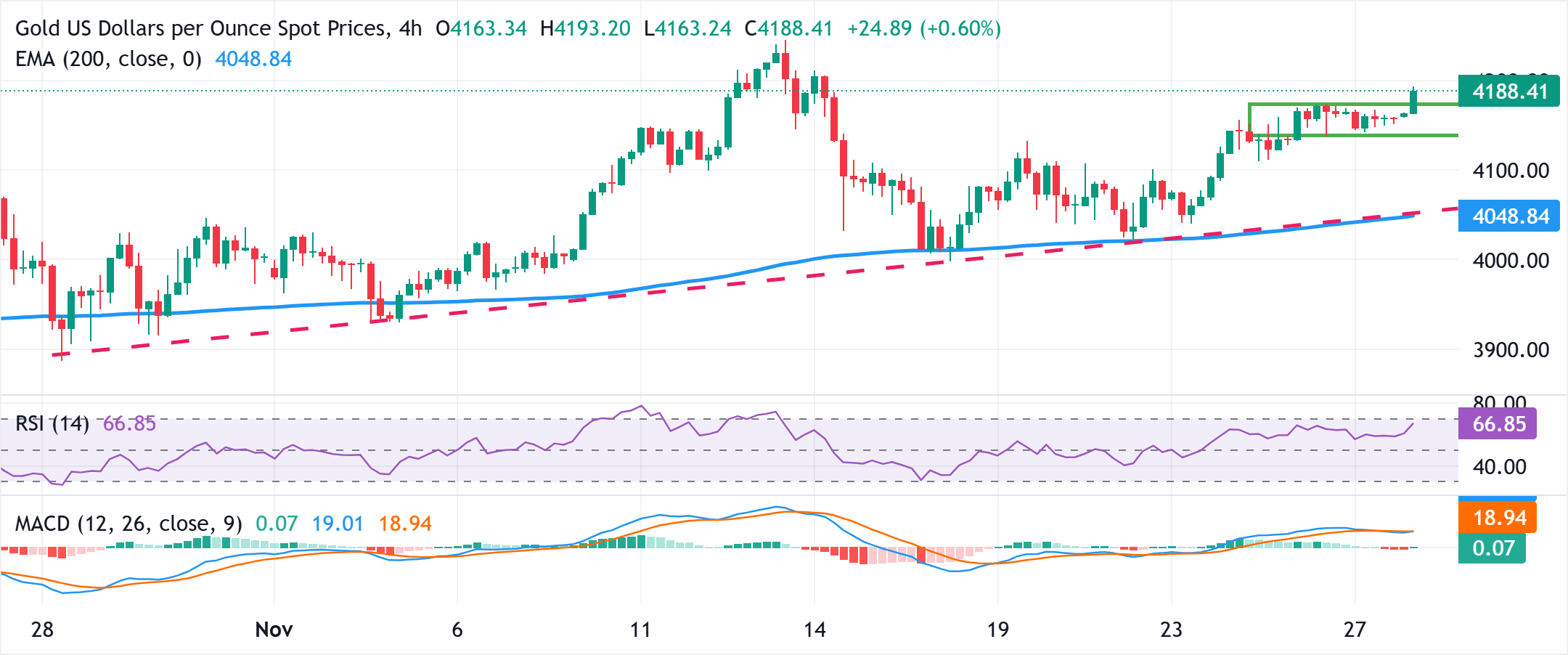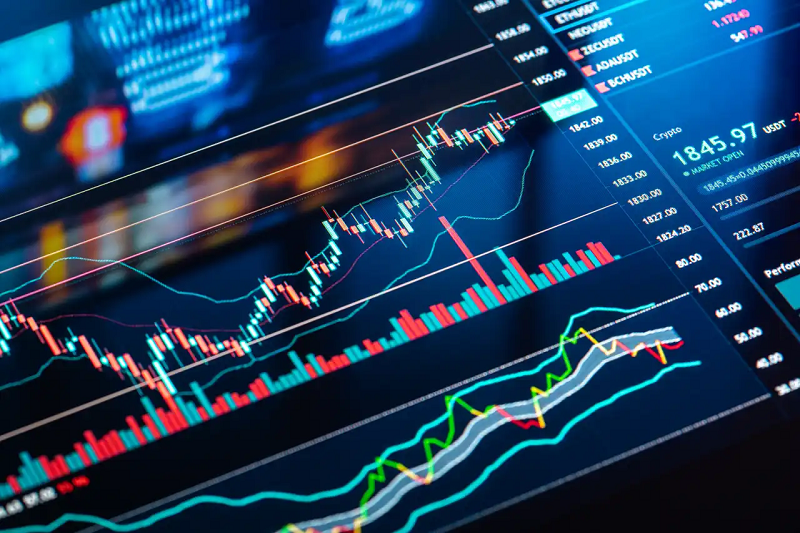Gold hits two-week top; eyes $4,200 as dovish Fed offsets USD uptick and risk-on mood

- Gold catches fresh bids on Friday amid rising bets for another Fed rate cut in December.
- The XAU/USD bulls seem rather unaffected by a modest USD uptick and the risk-on mood.
- A break through a consolidative trading range might have set the stage for further gains.
Gold (XAU/USD) attracts fresh buyers during the Asian session on Friday and climbs to a two-week high, with bulls now eyeing to reclaim the $4,200 mark amid dovish US Federal Reserve (Fed) expectations. The increasing likelihood of another interest rate cut by the US Federal Reserve (Fed) in December turns out to be a key factor that continues to benefit the non-yielding yellow metal. The intraday move up could further be attributed to some technical buying above the $4,170-4,175 supply zone.
The US Dollar (USD), however, looks to build on the previous day's modest bounce from an over one-week low and could act as a headwind for the Gold. Apart from this, the prevalent risk-on environment, bolstered by the prospects for lower US interest rates and hopes for a Russia-Ukraine peace deal, might cap the safe-haven precious metal. Nevertheless, the XAU/USD pair seems poised to register strong weekly gains, and a move beyond the $4,200 mark should pave the way for further gains.
Daily Digest Market Movers: Gold continues to be underpinned by dovish Fed expectations
- The recent dovish remarks from several Federal Reserve officials suggested that another interest rate cut in December is a live option. Moreover, a mixed set of US economic indicators released this week did little to alter expectations, pushing the non-yielding Gold to a two-week high during the Asian session on Friday.
- Adding to this, reports suggest that White House economic adviser Kevin Hassett has emerged as the frontrunner to become the next Fed Chair and is widely expected to enact US President Donald Trump's calls for sharply lower interest rates. This offsets a modest US Dollar uptick and also acts as a tailwind for the commodity.
- Russian President Vladimir Putin said that the revised US proposal could form the basis of a future Ukraine agreement, but only if Ukraine pulls its troops out of areas Moscow claims as its own. Putin also warned that Russia will take the territory by force if Ukraine refuses. Ukraine has repeatedly said it will not give up any land.
- Meanwhile, Kremlin spokesman Dmitry Peskov cautioned that an agreement is a long way off and Moscow would offer no major concessions. Trump, however, said that a Ukraine–Russia agreement is very close. Nevertheless, this keeps geopolitical risks in play and further benefits the precious metal's safe-haven status.
- The supporting factor, to a larger extent, offsets a modest uptick in the US Dollar, which is looking to build on the overnight bounce from a one-and-a-half-week low. Even the risk-on environment fails to dent the bullish sentiment surrounding the commodity. This, in turn, backs the case for additional near-term gains.
- There isn't any relevant market-moving economic data due for release from the US on Friday, leaving the XAU/USD pair at the mercy of Fed rate cut expectations and the broader risk sentiment. The fundamental backdrop, however, suggests that the path of least resistance for the commodity remains to the upside.
Gold bulls now await sustained strength beyond $4,200 before placing fresh bets

The latest leg up confirms a breakout through a consolidative trading range and validates the near-term positive bias for the Gold price. Some follow-through buying beyond the $4,200 mark will reaffirm the constructive outlook and lift the commodity further towards the monthly swing high, around the $4,245 region. A sustained strength beyond the latter will be seen as a fresh trigger for bullish traders and set the stage for an extension of the recent move up witnessed over the past week or so.
On the flip side, weakness below the trading range hurdle breakpoint, around the $4,175-4,170 region, now seems to find decent support ahead of the $4,150 level. A convincing break below, however, might drag the Gold price to the $4,120-4,115 intermediate support en route to the $4,100 mark, which, if broken, would expose the $4,050-4,040 confluence. The latter comprises the 200-period Exponential Moving Average (EMA) on the 4-hour chart and an ascending trend-line extending from late October. Failure to defend the said support level will negate the positive outlook and pave the way for deeper losses.
Gold FAQs
Gold has played a key role in human’s history as it has been widely used as a store of value and medium of exchange. Currently, apart from its shine and usage for jewelry, the precious metal is widely seen as a safe-haven asset, meaning that it is considered a good investment during turbulent times. Gold is also widely seen as a hedge against inflation and against depreciating currencies as it doesn’t rely on any specific issuer or government.
Central banks are the biggest Gold holders. In their aim to support their currencies in turbulent times, central banks tend to diversify their reserves and buy Gold to improve the perceived strength of the economy and the currency. High Gold reserves can be a source of trust for a country’s solvency. Central banks added 1,136 tonnes of Gold worth around $70 billion to their reserves in 2022, according to data from the World Gold Council. This is the highest yearly purchase since records began. Central banks from emerging economies such as China, India and Turkey are quickly increasing their Gold reserves.
Gold has an inverse correlation with the US Dollar and US Treasuries, which are both major reserve and safe-haven assets. When the Dollar depreciates, Gold tends to rise, enabling investors and central banks to diversify their assets in turbulent times. Gold is also inversely correlated with risk assets. A rally in the stock market tends to weaken Gold price, while sell-offs in riskier markets tend to favor the precious metal.
The price can move due to a wide range of factors. Geopolitical instability or fears of a deep recession can quickly make Gold price escalate due to its safe-haven status. As a yield-less asset, Gold tends to rise with lower interest rates, while higher cost of money usually weighs down on the yellow metal. Still, most moves depend on how the US Dollar (USD) behaves as the asset is priced in dollars (XAU/USD). A strong Dollar tends to keep the price of Gold controlled, whereas a weaker Dollar is likely to push Gold prices up.







